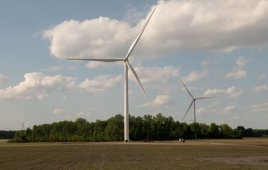
When the cap at the top of the Rotabolt does not turn at a finger's touch, the bolt is properly tightened.
Construction standards say to check the tension of the bolts on a wind turbine and tower after it’s been working for 500 to 600 hours. That task can take a couple days because there are many bolts to check. However, bolts with built-in tension-sensing devices can reduce the task to one hour. What’s more, preventative maintenance is easier across a wide range of applications and without sophisticated test equipment thanks to two bolt mounted devices.
One bolt with a tension indicator is the Rotabolt, from EGC, Chardon, Ohio. These fasteners provide a permanent indication of load level. A gauge pin made of the same basic material as the parent fastener is anchored in a shallow central hole. The Rota-load indicator, which is free to rotate on the pin, is set at a prescribed air-gap in the head of the machined fastener. The dimension of this air-gap is set according to a selected percent yield stress.
A cap on the load indicator protects the assembly while a lubricant in the cap protects key components. The knurled cap is easily rotated at finger touch when the fastener is not fully stressed. After loading the fastener, the air-gap closes because of a small elongation that occurs. The bolt is tightened to the correct load setting when the Rota-load indicator no longer turns by finger-tip. These load monitored fasteners consistently indicate within ±5% of the selected design load regardless of environmental influences.

The VLI from EGC has a dial indicator in the bolt head. When it reaches torque, the indicators line up. No touching is needed.
All fasteners are affected after a period in service by temperatures, gasket relaxation, pressure fluctuations, and vibration. If the Rota-load indicator turns freely (by turning the control cap) the bolt needs further tightening to restore the correct load.
The second bolt tension device and the company’s newest fastener is the VLI or Visual Load Indicator. It looks as if the bolt head holds a dial indicator. It provides a visual tension indication on a variable scale where as the Rotabolt is go/no-go system. Thus, the operator can tighten the fastener and know when the tension being applied is under, at, or over the specification – and by how much.
At the time of this posting, VLI was beginning Phase II field trials. The device’s advantage over a Rotabolt is that it provides maintenance people with a visual check rather then a tactile one. Thus, to check a VLI bolt you can be 25 to 30 ft away with the naked eye or with binoculars you could be farther away.
Filed Under: Uncategorized




